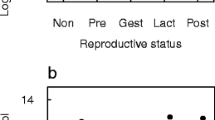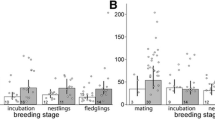Abstract
The effect of routine captive procedures on the welfare of species used as experimental models in biomedical research is of great interest, since stress may alter the generalization and interpretation of results. This study investigated behavioral and endocrine (fecal cortisol) reactivity patterns in common marmoset (Callithrix jacchus) adult males (N = 10) and females (N = 9) subjected to three types of routine procedures in captivity: (1) moving to a same-sized cage (P1), to a smaller cage (P2), and (2) first-time pair formation (P3). Sexually dimorphic cortisol responses were detected in animals submitted to a physical environmental stressor (cage change). Females showed an increased response throughout P1, in relation to baseline (BP) cortisol, and a trend during P2. Males increased cortisol only during P2. On the other hand, males and females showed a similar endocrine response when management involved social challenge (pair formation), with both sexes increasing cortisol levels, but females exhibited a more intense and longer-lasting cortisol increase. Males and females exhibited similar behavioral responses to cage change, except for autogrooming, with males decreasing this behavior in P1. Only females demonstrated a significantly higher increase in piloerection frequency than that of males during the pair formation phase. These endocrine and behavioral changes must be taken into account when interpreting research data that involve these types of procedures. Further studies on the impacts of routine colony management are required to devise and include protocols in official husbandry guidelines.




Similar content being viewed by others
References
Altmann J (1974) Observational study of behavior: sampling methods. Behaviour 49:227–267
Baker KC (2007) Enrichment and primate centers: closing the gap between research and practice. J Appl Anim Welf Sci 10:49–54
Baker KC, Weed JL, Crockett CM, Bloomsmith MA (2007) Survey of environmental enhancement programs for laboratory primates. Am J Primatol 69:377–394
Balcombe JP, Barnard ND, Sandusky C (2004) Laboratory routines cause animal stress. Contemp Top Lab Anim Sci 43:42–51
Barros M, Tomaz C (2002) Non-human primate models for investigating fear and anxiety. Neurosci Biobehav Rev 26:187–201
Boere V (2001) Behavior and environment enrichment. In: Fowler ME, Cubas ZS (eds) Biology, medicine and surgery of South American wild animals. Iowa University Press, Ames, pp 263–266
Buchanan-Smith H, Jones-Engel L, Farmer K, Prescott M, Fitch-Snyder H, Tayor S (2007) IPS international guidelines for the acquisition, care and breeding of nonhuman primates. International Primatological Society
Charmandari E, Tsigos C, Chrousos G (2005) Endocrinology of the stress response. Annu Rev Physiol 67:259–284
Cohen S, Wills TA (1985) Stress, social support, and the buffering hypothesis. Psychol Bull 98:310–357
Crockett CM, Bowers CL, Shimoji M, Leu M, Bowden DM, Sackett GP (1995) Behavioral responses of longtailed macaques to different cage sizes and common laboratory experiences. J Comp Psychol 109:368–383
Dawkins MS (2004) Using behaviour to assess animal welfare. Anim Welf 13:19–30
Dettling A, Feldon J, Pryce CR (2002) Early deprivation and behavioral and physiological responses to social separation novelty in the marmoset. Pharmacol Biochem Behav 73:259–269
DeVries A, Craft TKS, Glasper ER, Neigh GN, Alexander JK (2007) Social influences on stress responses and health. Psychoneuroendocrinology 32:587–603
Dixson AF, Lunn SF (1987) Post-partum changes in hormones and sexual behaviour in captive groups of marmosets (Callithrix jacchus). Physiol Behav 41:577–583
Erkert HG (1989) Characteristics of the circadian activity rhythm in common marmosets (Callithrix jacchus). Am J Primatol 17:271–286
Galvão-Coelho NL, Silva HPA, Leão AC, Sousa MBC (2008) Common marmosets (Callithrix jacchus) as a potential animal model for studying psychological disorders associated with high and low responsiveness of hypothalamic-pituitary-adrenal axis. Rev Neurosci 19:187–201
Galvão-Coelho NL, Silva HP, de Sousa MB (2012) The influence of sex and relatedness on stress response in common marmosets (Callithrix jacchus). Am J Primatol 74:819–827
Gerber P, Schnell CR, Anzenberger G (2002) Behavioral and cardiophysiological responses of common marmosets (Callithrix jacchus) to social and environmental changes. Primates 43:201–216
Hennessy MB, Mendoza SP, Kaplan JN (2005) Behavior and plasma cortisol following brief peer separation in juvenile squirrel monkeys. Am J Primatol 3:143–151
Kishi N, Sato K, Sasaki E, Okano H (2014) Common marmoset as a new model animal for neuroscience research and genome editing technology. Dev Growth Differ 56:53–62
Kitchen AM, Martin AA (1996) The effects of cage size and complexity on the behaviour of captive common marmosets, Callithrix jacchus. Lab Ani 30:317–326
Kohu K, Yamabe E, Matsuzawa A, Onda D, Suemizu H, Sasaki E, Tanioka Y, Yagita H, Suzuki D, Kametani Y, Takai T, Toyoda A, Habu S, Satake M (2008) Comparison of 30 immunity-related genes from the common marmoset with orthologues from human and muse. Tohoku J Exp Med 215:167–180
Lacreuse A, Chang J, Metevier CM, Laclair M, Meyer JS, Ferris CM (2014) Oestradiol modulation of cognition in adult female marmosets (Callithrix jacchus). J Neuroendocr 26:296–309
Leão, AC (2001) Variação hormonal e comportamental em sagui comum (Callithrix jacchus), durante as fases de formação, separação e reunião do par heterosexual. M.Sc. Dissertation, Universidade Federal do Rio Grande do Norte, Brazil (in Portuguese)
Mansfield K (2003) Marmoset models commonly used in biomedical research. Comp Med 53:383–392
McEwen B (2000) The neurobiology of stress: from serendipity to clinical relevance. Brain Res 886:172–189
Newberry RC (1993) The space-time continuum and its relevance to farm animals. Etologia 3:219–234
Phillips KA, Hambright MK, Hewes K, Schilder BM, Ross CN, Tardif SD (2015) Take the monkey and run. J Neurosci Methods 248:27–31
Prasad S, Humphreys I, Kireta S, Gilchrist RB, Bardy P, Russ GR, Coates PTH (2007) The common marmoset as a novel preclinical transplant model: identification of new MHC class II DRB alleles and prediction of in vitro alloreactivity. Tissue Antigens 69:72–75
Raminelli JLF, Sousa MBC, Cunha MS, Barbosa MFV (2001) Morning and afternoon patterns of fecal excretion of cortisol among reproductive and non-reproductive male and female common marmosets, Callithrix jacchus. Biol Rhythm Res 32:159–167
Ruby S, Buchanan-Smith HM (2015) The effects of individual cubicle research on the social interactions and individual behavior of brown capuchin monkeys (Sapajus apella). Am J Primatol 77:1097–1108
Rylands AB (1985) Tree-gouging and scent-marking by marmosets. Anim Behav 33:1365–1367
Schapiro SJ, Lambeth SP, Jacobsen KR, Williams LE, Nehete BN, Nehete PN (2012) Physiological and welfare consequences of transport, relocation, and acclimatization of chimpanzees (Pan troglodytes). Appl Anim Behav Sci 137:183–193
Shively CA, Willard SL (2012) Behavioral and neurobiological characteristics of social stress versus depression in nonhuman primates. Exp Neurol 233:87–94
Shively CA, Register TC, Friedman DP, Morgan TM, Thompson J, Lanier T (2005) Social stress-associated depression in adult female cynomolgus monkeys (Macaca fascicularis). Biol Psychol 69:67–84
Silva HP, Sousa MBC (1997) The pair-bond formation and its role in the stimulation of reproductive function in female common marmosets, Callithrix jacchus. Int J Primatol 18:387–400
Smith TE, French JA (1997) Psychosocial stress and urinary cortisol excretion in marmoset monkeys (Callithrix kuhli). Physiol Behav. 62:225–232
Sousa MBC, Ziegler T (1998) Diurnal variation on the excretion patterns of steroids in common marmoset (Callithrix jacchus) females. Am J Primatol 46:105–117
Sousa MBC, Silva HPA, Leão AC (2002) Sexual differences on behavior and fecal cortisol using the separation paradigm in common marmosets, Callithrix jacchus. In: Abstracts, IPS conference, Beijing, p 94
Sousa MBC, Albuquerque ACSR, Yamamoto ME, Araújo A, Arruda MF (2009) Emigration as a reproductive strategy of the common marmoset (Callithrix jacchus). In: Ford SM Porter LM Davis LC (eds) The smallest anthropoids: the marmoset/callimico radiation. Springer Press, New York, pp 167–182
Sousa MBC, Galvão ACM, Sales CJR, Galvão-Coelho NL (2015) Endocrine and cognitive adaptations to cope with stress in immature common marmosets (Callithrix jacchus): sex and age matter. Front Psychiatry. doi:10.3389/fpsyt.2015.00160
Stevenson MF, Poole TB (1976) An ethogram of common marmoset (Callithrix jacchus): general behavioral repertoire. Anim Behav. doi:10.1016/S0003-3472(76)80053-X
Stevenson MF, Rylands AB (1988) The marmosets, genus Callithrix. In: Mittermeier RA, Rylands AB, Coimbra-Filho A, Fonseca GAB (eds) Ecology and behavior of neotropical primates. Contagem, Littera Maciel, pp 131–222
't Hart BA, Abbott DH, Nakamura K, Fuchs E (2012) The marmoset monkeys: a multi-purpose preclinical and translational model of human biology and disease. Drug Discov Today 17:1160–1165
Taylor JH, Mustoe AC, Hochfelder B, French JA (2015) Reunion behavior after social separation is associated with enhanced HPA recovery in young marmoset monkeys. Psychoneuroendocrinology 57:93–101
Wittig RM, Crockford C, Lehmann J, Whitten PL, Seyfarth RM, Cheney DL (2008) Focused grooming networks and stress alleviation in wild female baboons. Horm Behav 54:170–177
Ximenes MFFM, Sousa MBC (1996) Family composition and the characteristics of parental care during the nursing phase of captive common marmosets (Callithrix jacchus). Primates 37:175–183
Yamamoto ME, Araújo A, de Sousa MBC, de Fátima Arruda M (2010) Social organization in Callithrix jacchus: cooperation and competition. Adv Study Behav 42:259–273
Young RJ (2003) Environmental enrichment for captive animals. Blackwell Science, Oxford
Ziegler TE, Sousa MBC (2002) Parent-daughter relationships and social controls on fertility in female common marmosets, Callithrix jacchus. Horm Behav 42:356–367
Acknowledgments
We would like to thank Edinolia Câmara, Antonio B. da Silva, and Geniberto C. dos Santos for animal care, and José Flávio V. Coutinho and Janaína Nitta for veterinary care.
Author information
Authors and Affiliations
Corresponding author
Ethics declarations
Conflict of interest
The authors declare they have no conflicts of interest.
About this article
Cite this article
de Menezes Galvão, A.C., Ferreira, R.G., de Sousa, M.B.C. et al. Physiological and behavioral responses to routine procedures in captive common marmosets (Callithrix jacchus). Primates 57, 421–431 (2016). https://doi.org/10.1007/s10329-016-0526-2
Received:
Accepted:
Published:
Issue Date:
DOI: https://doi.org/10.1007/s10329-016-0526-2




